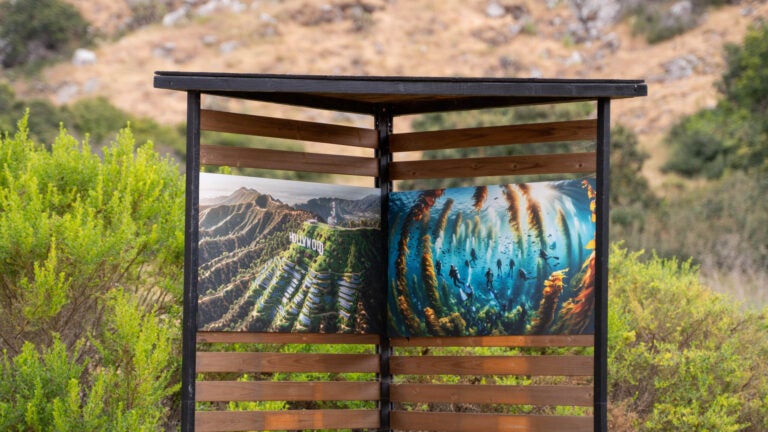
“City Ascendant: Imagining the Future of L.A. through A.I.,” a new Wrigley Institute art exhibit created in collaboration with the USC School of Cinematic Arts, on display at the Wrigley Marine Science Center’s outdoor Art Park (Vanessa Codilla/USC Wrigley Institute)
New A.I. generated art installation at the Wrigley Marine Science Center instills a hopeful climate vision for the future
Can you imagine a future for Los Angeles that centers sustainability? It might look like rows of solar panels installed below the iconic Hollywood Sign; gigantic container ships transformed into lush, oxygen-producing ecosystems; or even colorful city streets dotted with people and plants rather than gas-powered vehicles.
These are just a few of dream-like scenes depicted in a new Wrigley Institute art installation, “City Ascendant: Imagining the Future of L.A. through A.I,” created in collaboration with the USC School of Cinematic Arts.
Wrigley Institute Curator Allison Agsten’s goal for the project is to encourage viewers to conceive a thriving future for our planet that may be achievable through sustainability-centered changes that our society can make right now. A blend of both possibility and fantasy aimed to inspire expansive thinking, the depictions in the art installation depart from catastrophic climate imagery that is pervasive in the current media landscape, which often makes individual actions seem futile in the face of today’s climate crisis.
“We have plenty of evidence that doom-and-gloom climate communication and news coverage is not always successful. People shut down when they encounter too much of it,” said Agsten, who also serves as director for the USC Annenberg’s Center for Climate Journalism and Communication, created to train experts to effectively communicate their climate-related work.
“We want people to engage with [the art installation]. We don’t want them to step away from imagining what our future may look like because it seems so out of control and dark that it is hopeless. We want the opposite; we want hope.”

To image the possibilities of a brighter future, Agsten and Wrigley Institute Executive Director Jessica Dutton tapped on the expertise of USC School of Cinematic Arts Professor Kathy Smith, Expanded Animation Research + Practice program students Sijia Zheng and Zeping Sun, and computer science graduate student Charith Chandra Sai Balne. The team used generative artificial intelligence tools DALL-E 4 Chat GPT and Midjourney to help make the vision come to life in the artwork.
“When you think about the negative perception of our future due to climate change, which is often perpetuated in the media, there’s a similar attitude toward artificial intelligence,” said Smith. But with A.I., she argues, there is an opportunity for artists to become inspired by science and help experts accurately and effectively communicate their work.
Smith and the team worked closely with Wrigley Institute affiliated researchers to generate thought-provoking imagery based on prompts that were grounded in science. A.I. visual artists Sijia Zheng and Zeping Sun, who did not have much experience working with climate-related art prior to the start of their program, even visited the Wrigley Marine Science Center on Catalina Island to gather inspiration for their project.
“When I think about a reimagined future, I think about self-sufficiency,” said Sun. “When we went to [the campus on Catalina island], we learned about conservation efforts there such as collecting and reusing rainwater to help manage water needs. That’s something I imagine us doing more of in the future.” Sun kept this top-of-mind when working on the project and experimenting with different styles to create landscape imagery conveying harmony between people and their environment.
For Zheng, the highlight – and most challenging part – of the creative process was finding the realistic balance in the generated imagery. “A.I. tools can understand what solar power means. But they can’t effectively depict what thousands of solar panels under the Hollywood Sign might look like. As an artist, the challenge is working with A.I. to eventually generate an image that is both somewhat scientifically accurate and visually interesting.”

“City Ascendant: Imagining the Future of L.A. through A.I” made its debut as one of the featured artworks at this year’s Climate Forward Conference, hosted at USC’s University Park Campus during Earth Month to bring together students, experts, and the wider Los Angeles community to explore practical solutions to climate change. The exhibit is now on display at the Wrigley Marine Science Center’s Art Park.